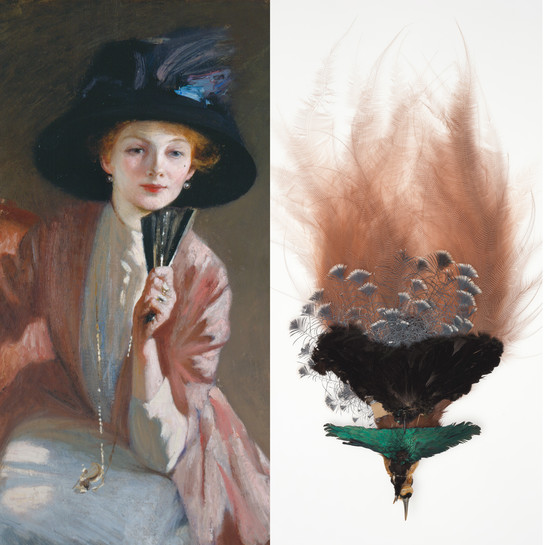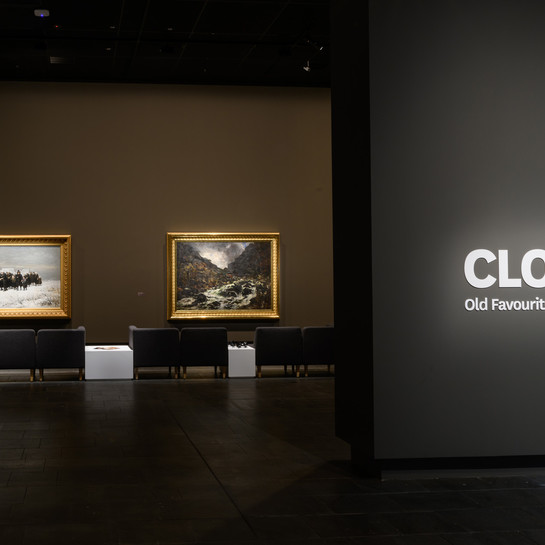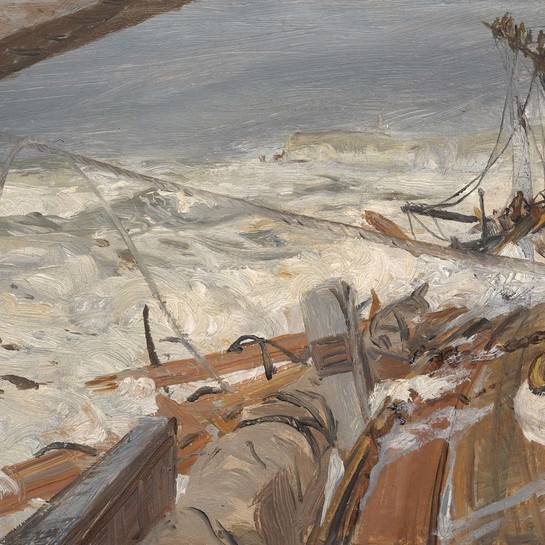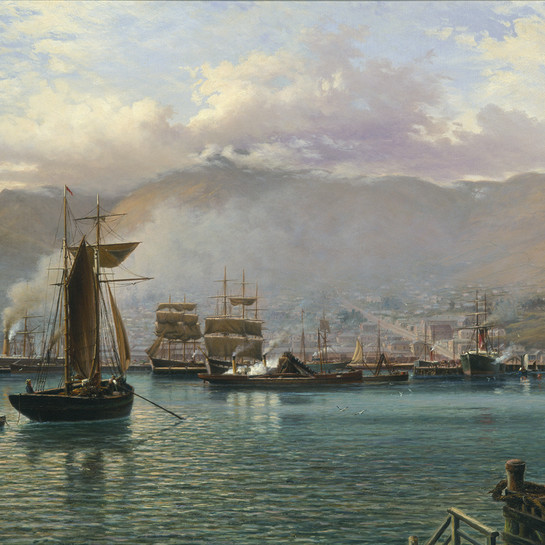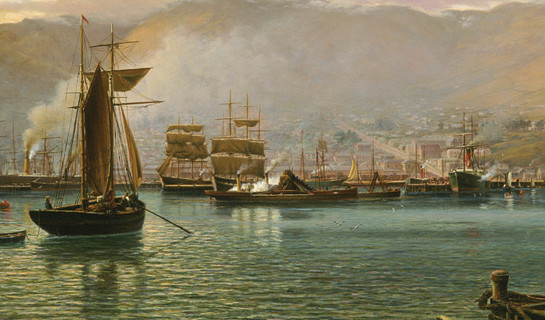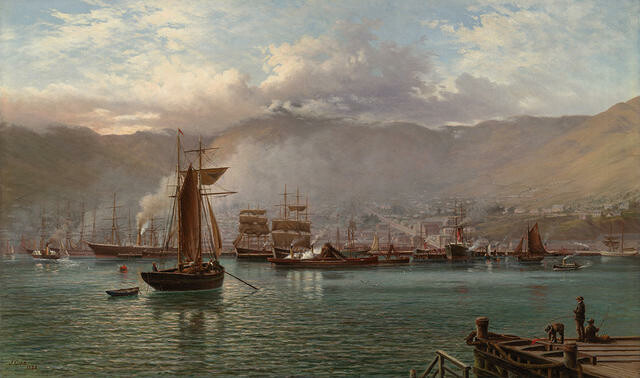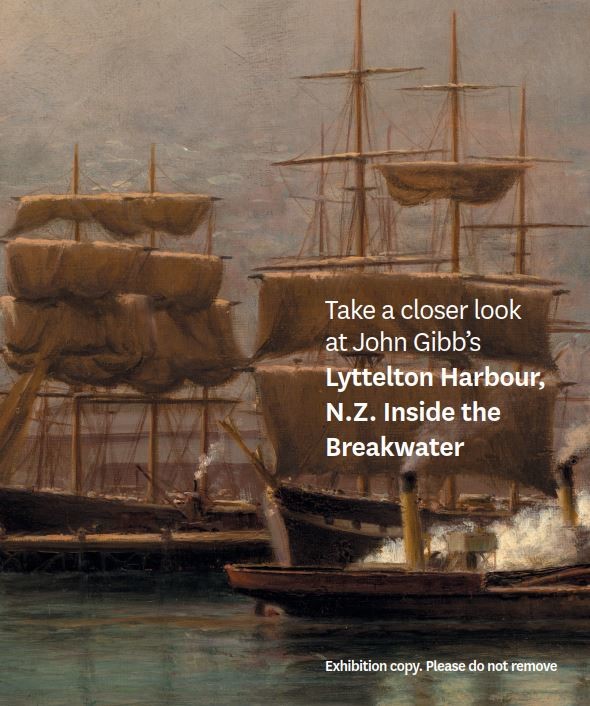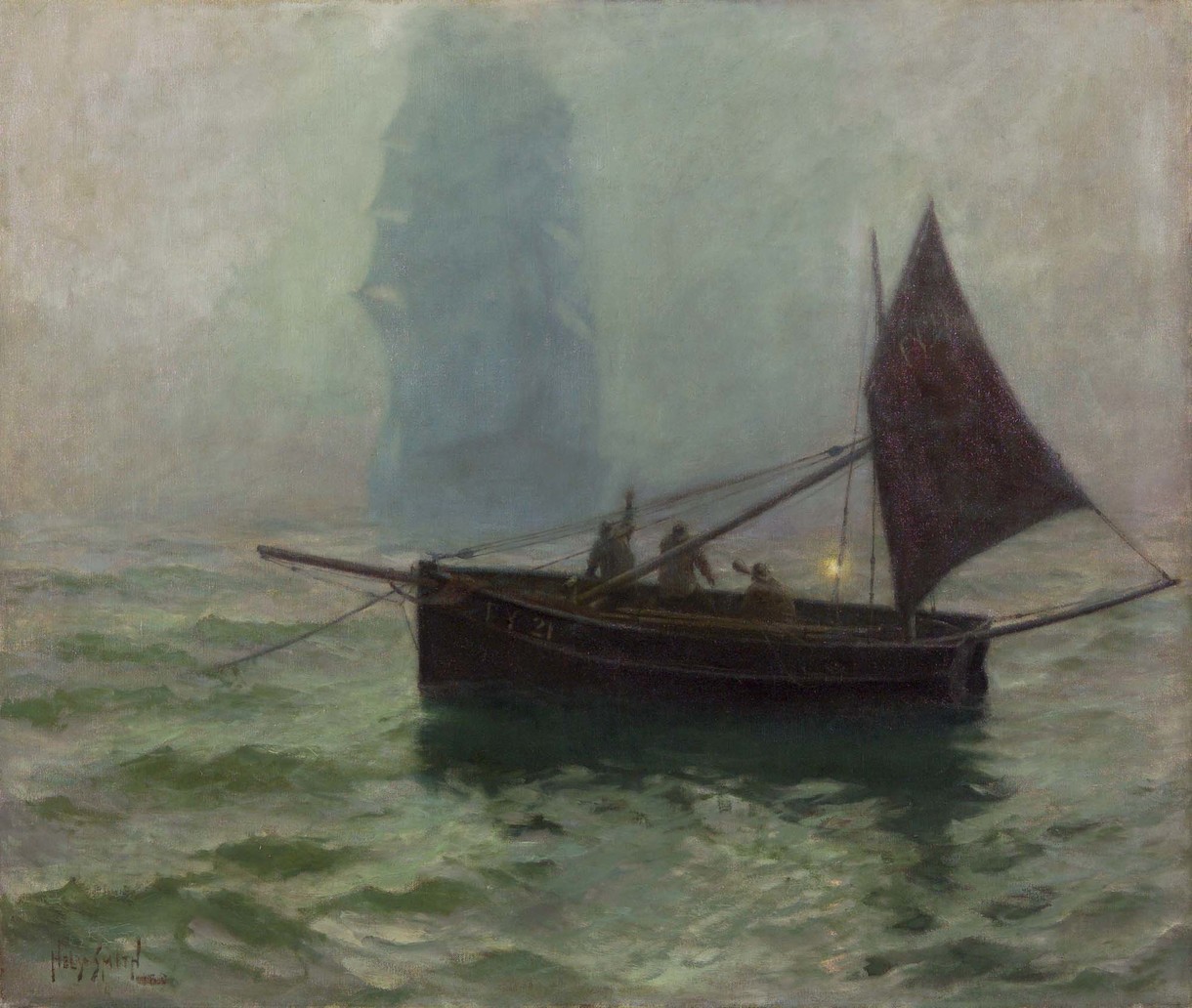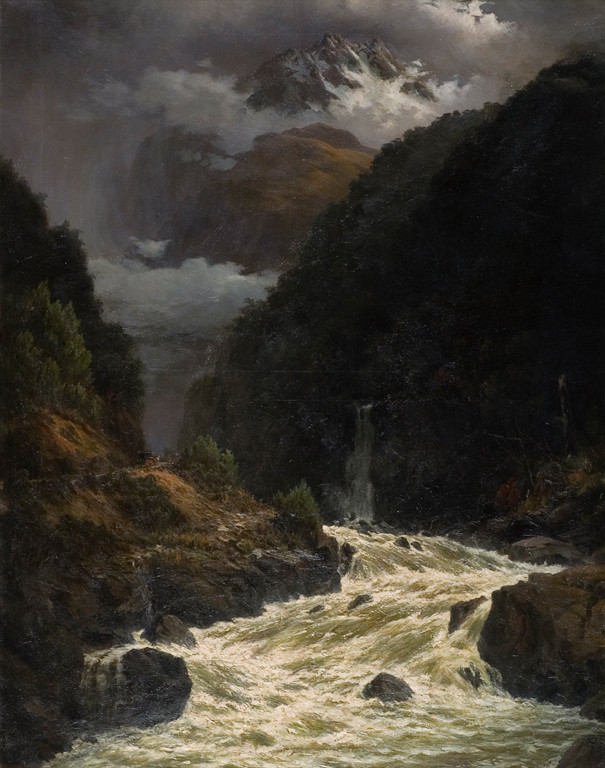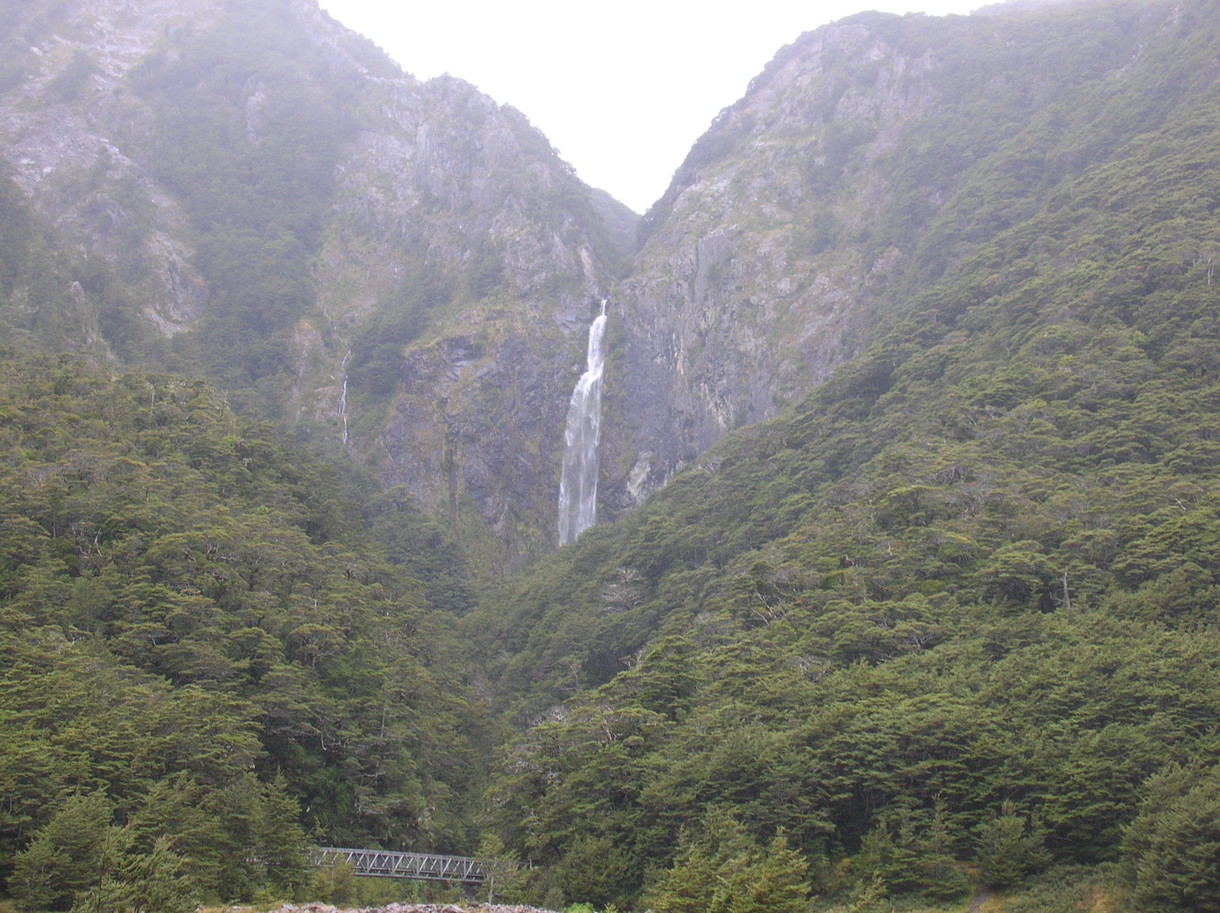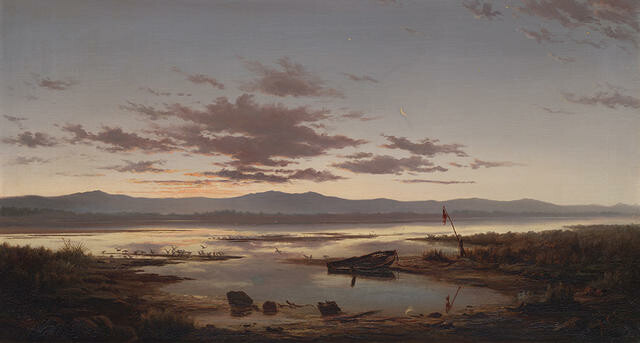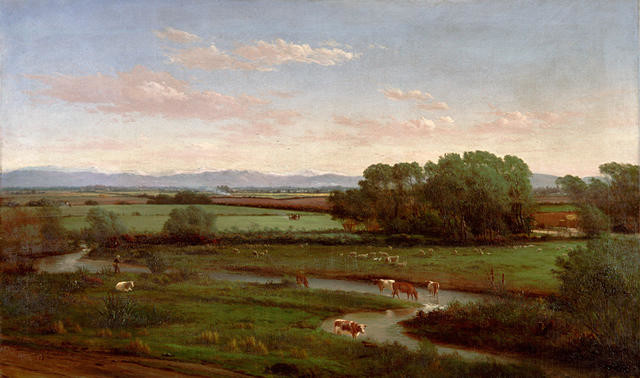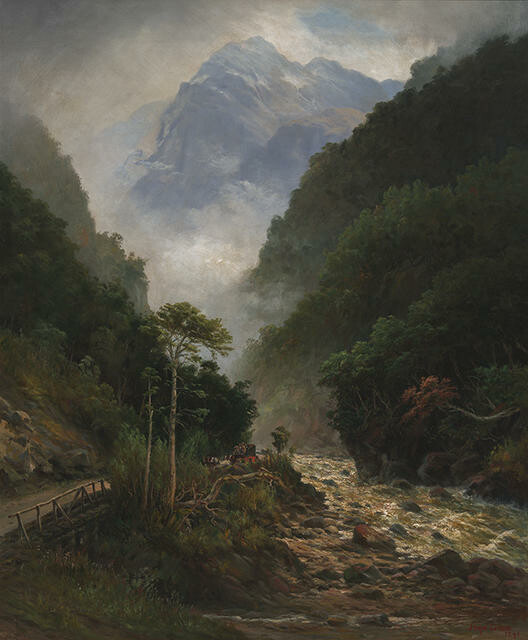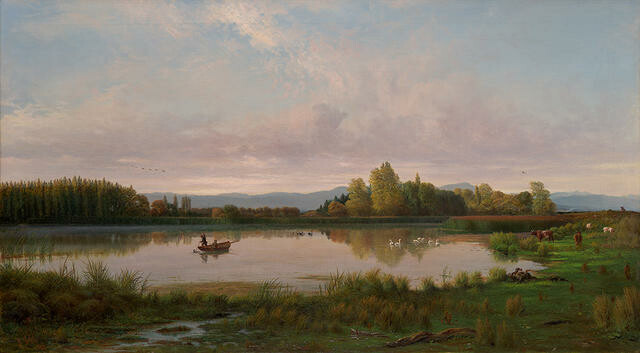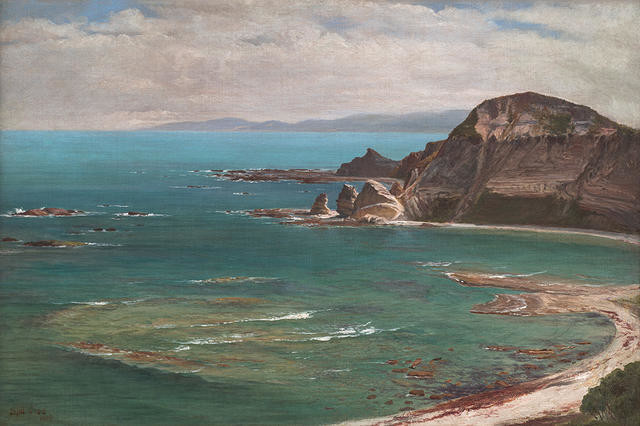John Gibb
Scotland / Aotearoa New Zealand, b.1831, d.1909
Lyttelton Harbour, N.Z. Inside the Breakwater
- 1886
- Oil on canvas
- Presented by the Lyttelton Harbour Board, 1989
- 1080 x 1590mm
- 89/209
- View on google maps
Tags: bays (bodies of water), boats, breakwaters, clouds, fishing, mountains, ports (settlements), reflections (perceived properties), sails (equipment), seas, ships, wharves
About the artist
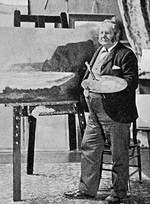
John Gibb in his studio
The Weekly Press, 12 December 1900, p. 62
Image supplied by Christchurch City Libraries (CCL-PhotoCD07-IMG0022)
John Gibb’s Lyttelton Harbour, N.Z., Inside the Breakwater shows a busy port full of ships unloading and loading their cargo. By 1886, when this painting was completed, the town of Ōhinehou Lyttelton had been settled by Pākehā for thirty-seven years, and the port had become one of New Zealand’s busiest. Whakaraupō Lyttelton Harbour provided welcome refuge for ships from Te Moana-nui-a-Kiwa the Pacific Ocean beyond the harbour’s heads, particularly once the breakwater had been completed. Gibb’s painting shows fishing boats, sailing and steam ships, a launch and even a rowboat plying the sheltered waters of the harbour, busily going about their business. It was first shown at the Colonial and Indian Exhibition at the Royal Albert Hall in London in 1886, where it would have served well in promoting the progressive industry of the port and the prosperity of the Canterbury Province to an international audience.
(Ship Nails and Tail Feathers, 10 June – 22 October 2023)
Exhibition History
Reading the Swell, 3 September 2016 – 6 February 2017
As with Petrus van der Velden’s The Leuvehaven, this painting by John Gibb provides a view of a bustling port where ships come and go, unloading and loading their cargo. By 1886, when this painting was completed, the town of Lyttelton / Ōhinehou had been settled by pākehā for just over thirty-six years, and the port had become one of New Zealand’s busiest. Lyttelton Harbour / Whakaraupō provided welcome refuge for ships from the Pacific Ocean beyond the harbour heads, particularly once the breakwater had been completed. Gibb's painting shows fishing boats, sailing and steam ships, a launch and even a rowboat plying the sheltered waters of the harbour, busily going about their business. It was first shown at the Colonial and Indian Exhibition at the Royal Albert Hall in London in 1886, where it would have served well in promoting the progressive industriousness of the port and the prosperity of the Canterbury Province to an international audience.
John Gibb, 18 December 2015 – 28 August 2016
Gibb loved painting shipping scenes, revelling especially in the detail of rigging and sails. He was regarded as one of New Zealand's most successful maritime painters during his lifetime. This work was painted just thirty-six years after the arrival from England of the Canterbury Association settlers in 1850, and it is remarkable just how quickly the Port of Lyttelton grew.
Lyttelton was built on the site of an ancient pā (fortified village) called Ōhinehou, and the bay altered dramatically with the arrival of European settlers: land was reclaimed, and breakwaters and wharves were built allowing ever- greater numbers of vessels to use the port. The rail tunnel through the Port Hills was opened in 1867, providing a direct link with the rapidly developing city of Christchurch.
This painting served to promote the Canterbury Province as progressive, industrious and economically successful, with the Port of Lyttelton playing a central role in this success. In this light, it’s not surprising that the painting was first shown at the Colonial and Indian Exhibition at the Royal Albert Hall in London in 1886, where it would have served well in promoting the prosperity of the Canterbury Province to an international audience.
Brought to light, November 2009- 22 February 2011
Painted just thirty-six years after the arrival of the first British immigrants to the new settlement of Canterbury in 1850, this painting highlights just how quickly New Zealand towns prospered in the years after initial settlement. The once quiet bay known as Ohinehou was renamed Lyttelton and became the main settlement for the Canterbury Association settlers in 1850. As the Canterbury Province grew, Lyttelton’s port flourished; the bay was altered dramatically, with land reclamation, breakwaters and wharves allowing ever-greater numbers of vessels to use the port, while a rail tunnel through the Port Hills, opened in 1867, provided a direct link with Christchurch.
John Gibb has given great attention to detail, capturing the atmosphere of this busy working port, 36 years after the arrival of the first four ships bringing British immigrants to the then new settlement of Canterbury. The panoramic view looks back across Lyttelton township to the hill barrier (known as the Port Hills) between the harbour and Christchurch. A Scottish academic realist, Gibb had a keen interest in capturing the atmospheric conditions at different times of the day. He was largely unrivalled as a marine artist in New Zealand. Gibb was born in Cumbernauld, Scotland. He received tuition from John McKenzie at Greenockand, in 1861, began exhibiting at the Royal Scottish Academy. In 1868, however, he began exhibiting at the more progressive Royal Glasgow Institute of Fine Arts. Gibb emigrated to New Zealand in 1876. He settled in Christchurch, was a founding member of the Canterbury Society of Arts and travelled widely in New Zealand, painting many different regions. (Opening Gallery hang, 2003)
John Gibb made many studio paintings of Lyttelton Harbour during the almost 30 years that he was active as an artist in Christchurch.
He saw the harbour as a place of changing activity and responded not only to the topographical aspects of the harbour landscape but also the atmosphere it evoked.
By 1886, when this work was painted, a breakwater at Lyttelton had been constructed which enclosed a large inner harbour that could accommodate a diversity of shipping including as many as 22 ocean going ships, 20 barges and brigs, eight intercolonial steamers and 30 schooners, and other smaller craft. Gibb’s view observed from the breakwater shows a large assembly of many of these vessels, revealing Lyttelton to be one of New Zealand’s busiest ports.
Born at Cumbernauld, Scotland, John Gibb developed an early interest in art and studied in the studio of John McKenzie at Greenock. He also exhibited at the West of Scotland and Glasgow Institute of Fine Arts. Prior to emigrating to New Zealand in 1876 he lived for some years on the Firth of Clyde. It was during this time that he developed his keen interest in marine subjects which became more dominant in his work in later years.
Once established in Christchurch, Gibb began taking pupils as well as producing a constant output of studio work which he exhibited widely. (lLabel date unknown, before 2002)
